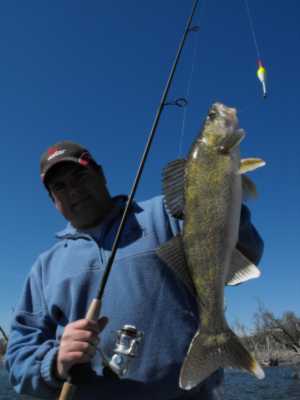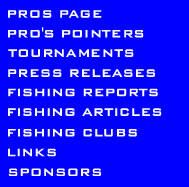| Flooded timber
can be a very productive pattern wherever walleye swim.
Some fisheries like North Dakota’s Devils Lake offer
strong year round patterns for walleye in the sticks.
While Devils Lake may be the most notorious, the Glacial
Lakes in South Dakota also offers similar situations where
walleye anglers find themselves fishing amongst flooded
trees. Besides the prairie lakes of the Dakotas that have
filled from a wet cycle that has flooded the rolling landscape,
timber can also be a productive option on flowages and
reservoirs. There are perhaps many reasons and theories
as to why flooded timber can be so productive from a biological
standpoint. First off, rising water or high water universally
seems to bring fish in shallow. Freshly flooded terrestrial
vegetation is extremely attractive to fish. This high
water that is often necessary to flood timber in itself
seems to pull fish shallow but when you combine this high
water with the cover that flooded timber provides, this
pattern becomes even more solid.
 |
From the bottom of the food chain, flooded
terrestrial vegetation brings a lot of new carbon
into the ecosystem. In a nutshell, this new water
becomes extremely productive with a spike in zoo plankton.
This added productivity combined with the cover often
boosts young of the year fish hatches. As long as
the water stays high or continues to rise, walleyes
can often be found shallow well into the summer long
past when tradition would dictate that these fish
slide deeper. Fishing the flooded timber often takes
a different mindset and also a modification of equipment
and tactics. On Devils Lake where I have made my living
as a guide for several years, we have flooded timber
that is submerged by as much as twenty feet of water
|
Over time, many of the flooded trees have
been pushed over by ice during the spring. As a result,
we are using our electronics more and more to find the
flooded timber. In the simplest form, fishing flooded
timber can be as easy as finding a stand of trees sticking
out of the water and tying off to one of the trees. One
of the most effective and popular methods of fishing flooded
timber is using a slip bobber.
Using slip bobbers to fish flooded timber
is very methodical but productive. The advantage of using
a slip bobber rig is that you can keep your presentation
vertical and away from the boat allowing an angler to
probe openings and lanes in the flooded timber. The slip
bobber also suspends the bait at a set depth to avoid
contact with the bottom where snags often occur. With
this type of presentation, remember that this is not a
case for finesse. Anglers often have to wrestle fish up
out of the branches relatively quickly. Many walleye anglers
using slip bobbers around the country often use a monofilament
line. The durability of braid however makes walleye anglers
much more efficient when fishing flooded timber. The downside
of most braids however is that the bobber stops have a
tendency to slide up and down on the line too easily where
resetting the depth is often necessary after catching
a fish. This past year, I have stumbled onto a new line
called Vicious Braid that is the best line I have found
for this type of fishing because bobber stops grip much
better. Vicious Braid also absorbs less water and is much
more durable and resilient than many of the other braids
I have used.
There are a few adjustments anglers can
do to their slip bobber rig to make them more efficient
in the timber. When we are guiding, what we often do is
tie a small snap swivel onto the end of the braid and
use lighter pound test mono or fluorocarbon snells where
we tie either a plain hook or small jig. The advantage
of the snell is that when snagged, the lighter snell will
break but you still get your slip bobber along with bobber
stop back. Anglers often add a few split shots above the
snap swivel but I find an egg sinker works better as the
egg sinker doesn’t tangle in the net as easy making
it faster to flip fish out of the net and get back into
the water. Another option when targeting bigger fish perhaps
in a tournament setting is to not use the lighter snell
and instead tie the jig directly to the braid. Above the
jig and below the bobber, tie another bobber stop onto
the line to keep from loosing the bobber in the advent
of a snag.
Specifically for bobber fishing, we designed
an eight foot telescoping slip bobber rod that has the
back bone and length necessary for good hook sets and
for wrestling fish up out of the wood (www.jasonmitchellrods.com).
This rod called the Jason Mitchell Elite Series JMSS80SB
is unique in the fact that the rod blank itself is marked
with a white dot every foot of the rod blank. This can
make you much more efficient and fast when adjusting and
setting the depth because an angler can use the rod blank
as a ruler, quickly measuring the distance from the hook
to the bobber stop. This system is much faster than traditional
methods that incorporated clipping a lead depth finder
onto the line to set the depth. This measuring method
is much faster when fishing depths of less than fifteen
feet of water.
The biggest mistake we see many anglers
make when we are guiding is how anglers set the hook when
using slip bobbers. What I try and teach people when we
are guiding is set the hook with the reel. What that means
is when a slip bobber goes under, crank on the reel as
fast as you can, essentially setting the hook with the
reel. Reel fast and you will pick up any slack line and
you will see the rod start to load from the fish as you
continue reeling. As the rod loads, you can then set the
hook but the reeling is very important. A hard hook set
does nothing if there is a lot of slack line or if the
fish is swimming towards the boat. Reel fast and load
the rod. After the rod is loaded where you can actually
feel the fish, set the hook if necessary.
Editors Note: The author, Jason Mitchell
is a legendary guide on North Dakota’s Devils Lake
and operates one of the largest and reputable guide services
in the upper Midwest. Mitchell’s Guide Service can
be found online at: www.fishdevilslake.net or can be contacted
at: 701-662-6560
|



